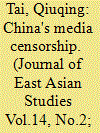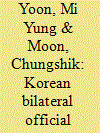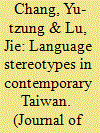|
|
|
Sort Order |
|
|
|
Items / Page
|
|
|
|
|
|
|
| Srl | Item |
| 1 |
ID:
132737


|
|
|
|
|
| Publication |
2014.
|
| Summary/Abstract |
Media censorship is the hallmark of authoritarian regimes, but much of the motivation and practices of autocratic media censorship still remain opaque to the public. Using a dataset of 1,403 secret censorship directives issued by the Chinese propaganda apparatus, I examine the censorship practices in contemporary China. My findings suggest that the Chinese Communist Party (CCP) is gradually adjusting its censorship practices from restricting unfavorable reports to a strategy of "conditional public opinion guidance." Over the years, the propaganda apparatus has banned fewer reports but guided more of them. However, this softer approach of regulating news is not equally enforced on every report or by different censorship authorities. First, the party tends to ban news that directly threatens the legitimacy of the regime. In addition, due to the speed with which news and photographs can be posted online, the authorities that regulate news on the Internet are more likely to ban unfavorable reports, compared with authorities that regulate slower-moving traditional media. Lastly, local leaders seeking promotions have more incentive to hide negative news within their jurisdictions than their central-level counterparts, who use media to identify misconduct among their local subordinates. Taken together, these characteristics create a strong but fragmented system of media regulation in contemporary China.
|
|
|
|
|
|
|
|
|
|
|
|
|
|
|
|
| 2 |
ID:
132736


|
|
|
|
|
| Publication |
2014.
|
| Summary/Abstract |
Are preferential trade agreements (PTAs) in the Asia-Pacific region merely a political phenomenon with no economic basis, as some critics say? I challenge this interpretation; in this article I present an explanatory model based on intra-industry trade to indicate what economic interests should drive Japanese and South Korean PTAs with ASEAN partners, and derive specific predictions. An analysis of the actual tariff barrier elimination in the agreements suggests important, but highly specific, economic benefits. First, preference margins are substantively greater for intra-industry trade, and second, intra-industry trade is much less likely to be excluded from tariff reductions when imported into Japan or South Korea. This indicates that PTAs help firms specialize their production throughout the region, and provides an economic rationale for these agreements. A qualitative case study of the Japan-Malaysia PTA and a statistical analysis of tariff liberalization in the PTAs of Japan and South Korea with the ASEAN countries support this view.
|
|
|
|
|
|
|
|
|
|
|
|
|
|
|
|
| 3 |
ID:
132740


|
|
|
|
|
| Publication |
2014.
|
| Summary/Abstract |
In the past several years, the Republic of Korea-a former least developed country (LDC) and aid recipient that became a donor-joined the "club of emerging donors" to Africa. In March 2006, President Roh Moohyun declared Korea's Initiative for Africa's Development. The initiative puts poverty reduction and socioeconomic development of African countries in the forefront. Using pooled cross-sectional time series data, in this study we examine the determinants of Korean bilateral official development assistance (ODA) to Africa for the period 1991-2011. The findings of the study suggest that the approach of Korean ODA does not differ significantly from that of many conventional donors whose ODA disbursement has had a dual purpose: to improve the welfare of developing countries and to serve self-interests.
|
|
|
|
|
|
|
|
|
|
|
|
|
|
|
|
| 4 |
ID:
132738


|
|
|
|
|
| Publication |
2014.
|
| Summary/Abstract |
We collected original experimental data, using the matched-guise technique, to examine the Taiwanese people's evaluational reactions to two major spoken languages in contemporary Taiwan: Mandarin and Taiwanese. Taking advantage of the effectiveness of the experimental technique in controlling for possible unobserved confounding variables, we clearly and systematically demonstrate that (1) language stereotypes do exist in today's Taiwan, and (2) there are some serious and significant implications for Taiwan's public opinion and democratic politics. Our data show that such language stereotypes are of great salience and consistently decoded for political issues, less so for socioeconomic issues, and almost insignificant for personality features. Our data also confirm that these language stereotypes are not just proxies of Taiwan's regional divisions; the Taiwanese people cognitively differentiate between the spoken languages' political and socioeconomic implications (despite some mild halo effect between the two).
|
|
|
|
|
|
|
|
|
|
|
|
|
|
|
|
| 5 |
ID:
132739


|
|
|
|
|
| Publication |
2014.
|
| Summary/Abstract |
In this article I analyze the extent and causes of party system fragmentation in Indonesia's provincial and district parliaments. Focusing on the results of the first three post-Suharto elections in 1999, 2004, and 2009, I first highlight that local-level fragmentation is not only generally higher than national-level fragmentation but also that it has consistently increased over the three elections and that fragmentation has been particularly high in Eastern Indonesia. I then explain these three trends as a result of three main factors: First, electoral institutions applied between 1999 and 2009 facilitated fragmentation and poor party system institutionalization, mainly due to the introduction of an open list system in 2009 and the absence of a parliamentary threshold at the local level. Second, low levels of party institutionalization progressively individualized local party politics and made it normal for candidates to switch to smaller parties if it suited their interests, thereby exacerbating fragmentation. Third, electoral campaigning for local parliaments has been dominated by traditional methods based on personal relationships and networks rather than lavish public relations campaigns with expensive TV ads, further reinforcing the effects of the first two factors.
|
|
|
|
|
|
|
|
|
|
|
|
|
|
|
|
|
|
|
|
|